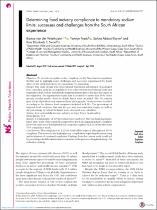| dc.contributor.author | van der Westhuizen, Bianca | |
| dc.contributor.author | Frank, Tamryn | |
| dc.contributor.author | Karim, Safura Abdool | |
| dc.date.accessioned | 2023-05-09T08:54:54Z | |
| dc.date.available | 2023-05-09T08:54:54Z | |
| dc.date.issued | 2023 | |
| dc.identifier.citation | van der Westhuizen, B. et al. (2023). Determining food industry compliance to mandatory sodium limits: Successes and challenges from the South African experience. Public Health Nutrition | en_US |
| dc.identifier.issn | 1475-2727 | |
| dc.identifier.uri | 10.1017/S1368980023000757 | |
| dc.identifier.uri | http://hdl.handle.net/10566/8910 | |
| dc.description.abstract | To provide an update on the compliance to the Na reduction regulation
(R.214) and to highlight some challenges and successes experienced by South
Africa in the implementation of a mandatory Na regulation. The study design was observational. Nutritional information of packaged
food (specified in the R.214 regulation) was collected between February 2019 and
September 2020, before and after the implementation date of the final Na targets in
the regulation. Six supermarket chains that accounted for more than 50 % of the
grocery retailer market share in South Africa were included. The Na content
(per 100 g) of products was extracted from photographs. Products were classified
according to the thirteen food categories included in R.214. The percentage of
targeted food categories that met the pre and post-regulation targets as well as
the percentage by which Na limits were exceeded was calculated. | en_US |
| dc.language.iso | en | en_US |
| dc.publisher | Cambridge University Press | en_US |
| dc.subject | Sodium | en_US |
| dc.subject | Public health | en_US |
| dc.subject | South Africa | en_US |
| dc.subject | Food security | en_US |
| dc.subject | Nutrition | en_US |
| dc.title | Determining food industry compliance to mandatory sodium limits: Successes and challenges from the South African experience | en_US |
| dc.type | Article | en_US |

